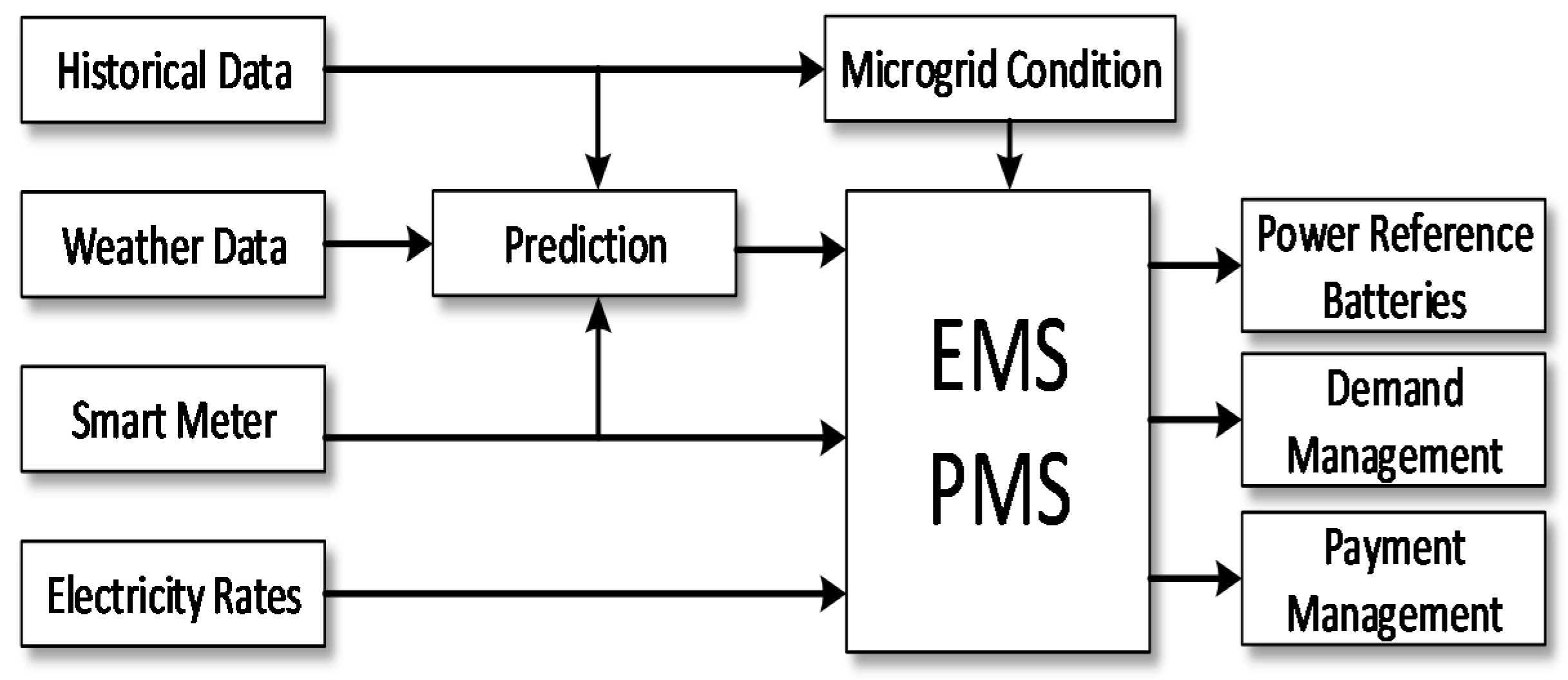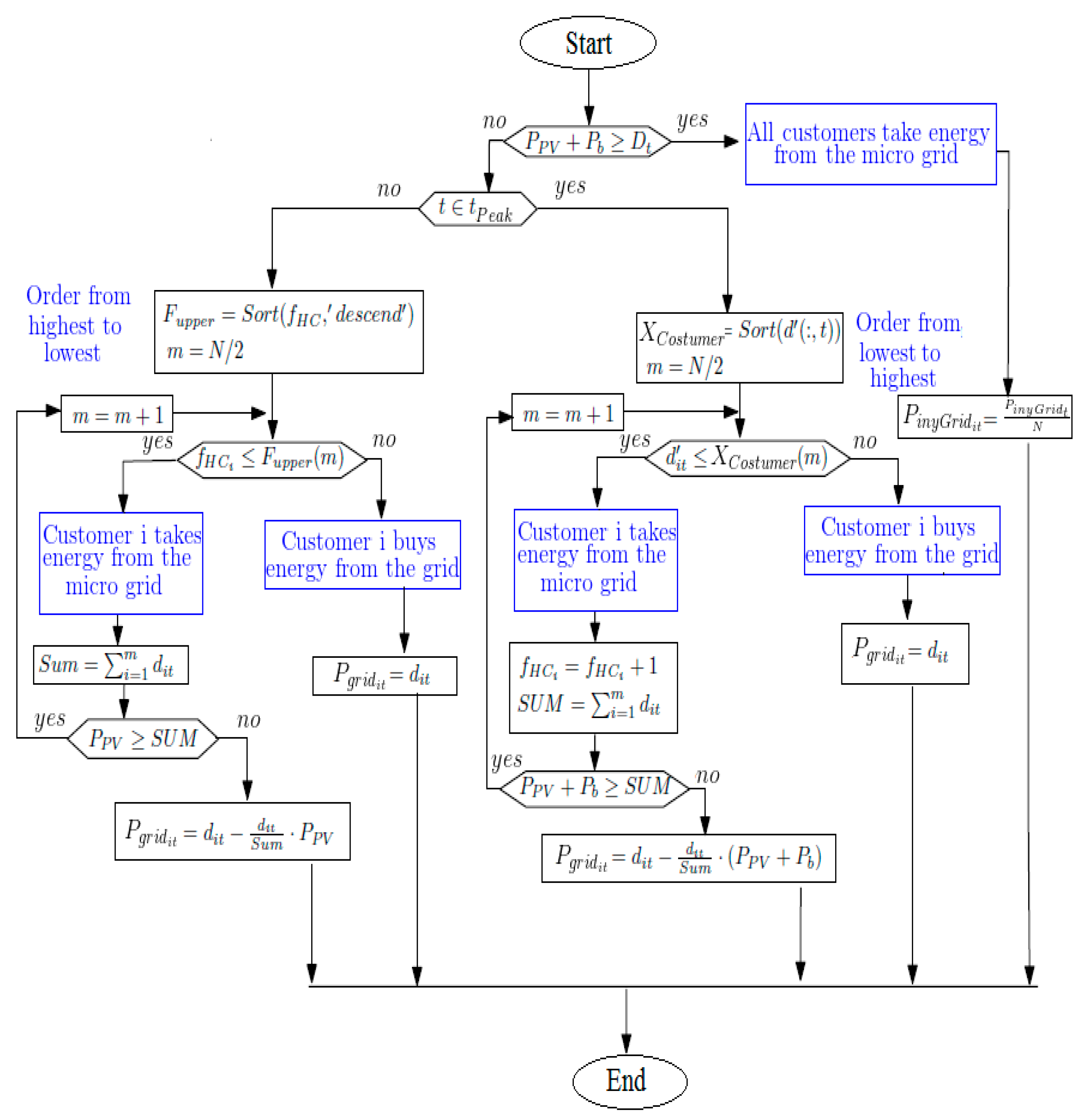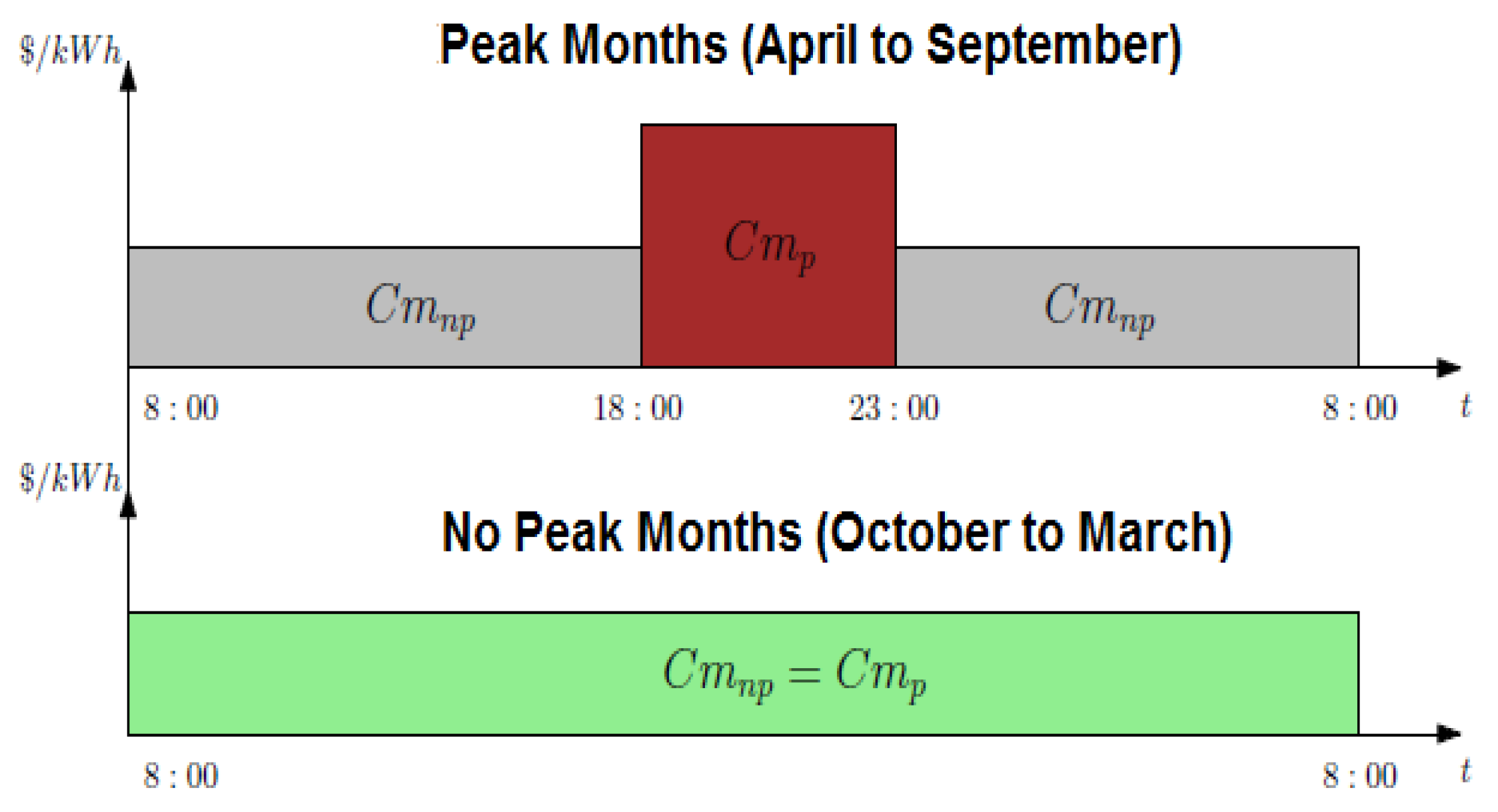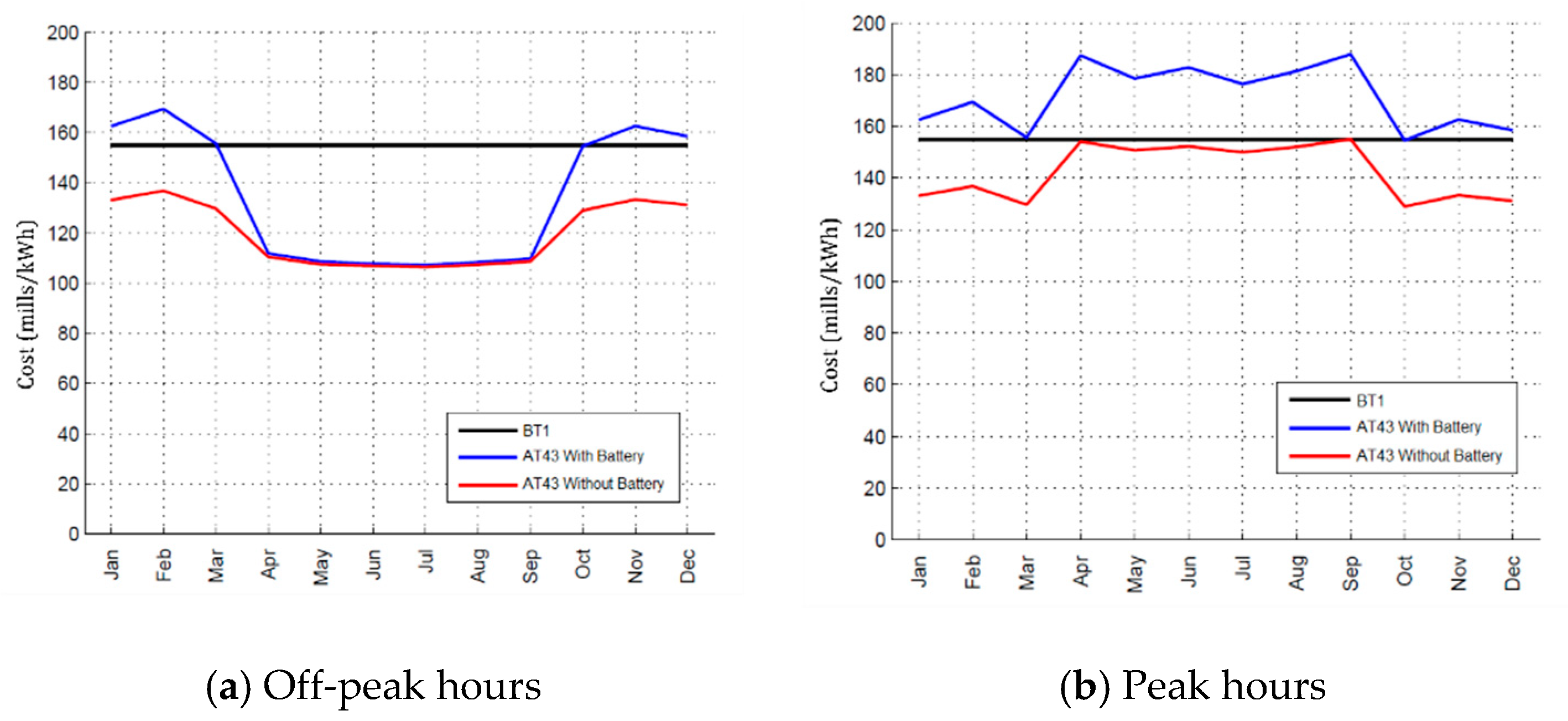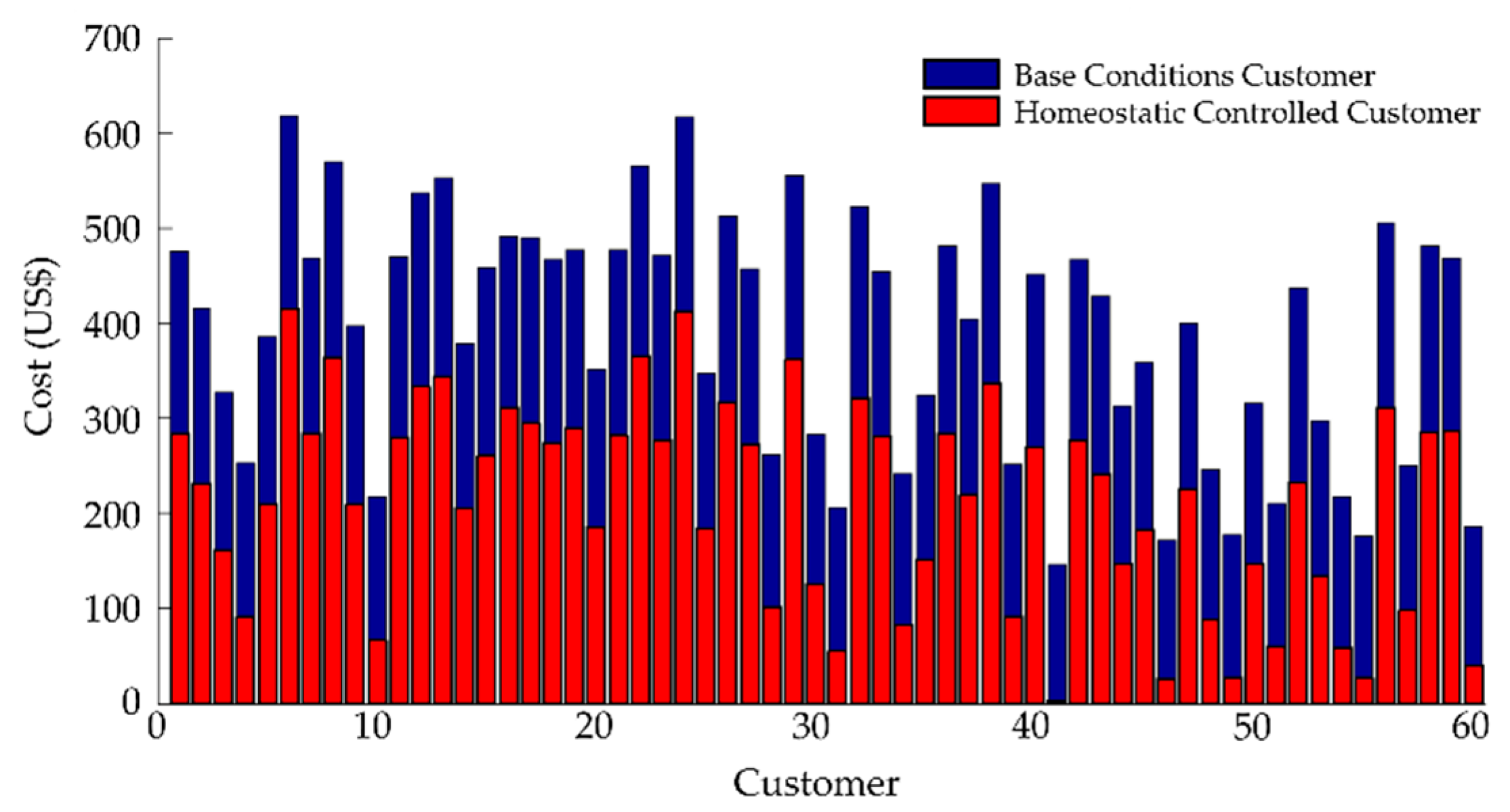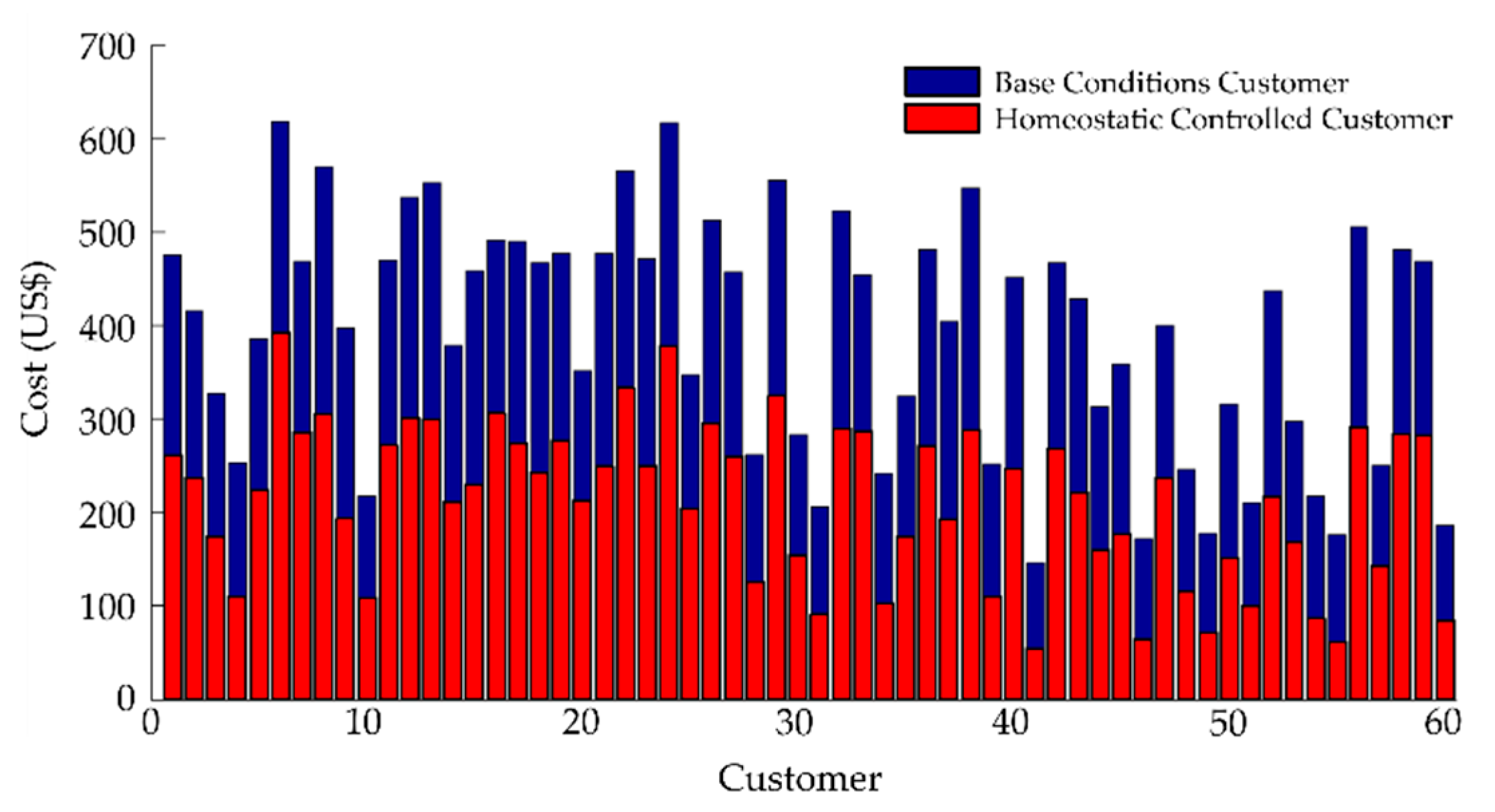1. Introduction
It is estimated by The International Energy Agency (IEA) that global energy demand will grow by more than 25% to 2040 [
1]. Thus, developing nations such as Chile are moving towards Integrated Resource Planning to advance green energy consumption, whereby the estimated demand and installation of distributed grid-connected generation systems are growing at rapid rate [
2,
3,
4,
5]. For distributed generation tied to the grid, the use of microgrids may be seen as an efficient solution by means of their flexibility and capacity to supply renewable energies. About 300 microgrid projects have been developed worldwide thus far, adding up to a total capacity exceeding 1.5 GW [
6]. Distributed Generation (DG) is defined as “an electric power source connected directly to the distribution network or on the consumer side of the meter” [
7]. Albeit important and desirable, in terms of expanding green energy consumption, the introduction of renewable distributed generation raises some issues and has consequences for the electricity supply services’ regulation and for the operation by the distribution system’s operators. Hence, industry regulation, especially in countries such as Chile, should aim to achieve: (1) a level playing field between centralized and distributed generation and (2) efficient operation of the distribution network [
2].
Benefits of distributed generation (DG) for consumers as well as for electric utilities is well documented in the literature [
8,
9]. The expected huge rise in electrical energy demand in a fast-approaching all-electric modern society scenario brings a set of challenges that can have very significant impact on the availability and demand for resources. Thus, to improve green energy generation, two strategies are outlined in this paper, both aimed at harnessing and maximizing available resources. Moreover, renewable and alternative energy resources integration and sustainability should be the electric sector’s regulation’s immediate focus. To overcome the challenge in the coming years, the main focus for investment should be on research and development of new technologies to advance such a trend, while pursuing a green revolution in renewables’ generation and energy management.
Specially designed microgrids, together with DG [
9] resources and independent small-scale systems can be integrated into urban or rural environments which can autonomously generate and store energy. The microgrid can be comprised of small gas turbines, microturbines, fuel cells, wind and solar energy, biomass, and small hydroelectric power, among other energy resources [
8]. On the other hand, the technical and economic advantages related to the implementation of DG in distribution networks have been widely investigated, such as the reduction of active and reactive energy losses, improvement in reliability, reduction of blackout probability, and peak hours demand reduction [
2]. Nevertheless, the regulatory aspects have not kept pace with technological advancements, as they have not been covered and revised in depth, presenting a hindrance for the industry’s plan to advance green energy integration in the electricity distribution sector [
10]. On the other hand, research on specific urban challenges, social impact of potential economic benefits drawn by industry policies and regulation needs remain to be an issue that is lagging behind and that should be extensively investigated [
3,
11].
In a relatively short period, between 2014 and 2020, the expected growth of investment in microgrids for commercial buildings was expected to grow by 94%; for medium size communities it is expected to grow by 199%; for public institutions by 228%; for large military installations by 142%; and finally, the microgrids that supply universities is expected to grow by 115% [
12]. Considering these growth rates, some authors propose that microgrids should be treated, in many ways, as a new power system [
4], incorporating those elements of analysis that are common to traditional electric power systems, such as stability analysis, frequency control, protection system response, electricity tariffs, and energy quality. The location of this new electric power system will depend largely on the customer’s location and on the availability of renewable energy sources and fuel resources such as natural gas to be used for small turbines and microturbines, as a perfect, rapid dispatching complement for solar energy generation and supply, including energy storage. This should decrease dependency on the network operator or the authority [
8,
13].
These new consumers, termed “prosumers” by some authors [
14], can become relevant actors in the future electricity distribution scenario and they may require clear signals from the tariffs viewpoint. Indeed, this is advisable so that the behavior of prosumers is aligned with the proper functioning and optimality of the electrical systems. Some authors have suggested establishing demand side management (DSM) systems together with dynamic pricing [
15] as part of the solution. Other researchers have done research quite extensively on this very subject, advocating for different schemes of energy consumption and energy sharing made possible by novel energy management and power control systems based on energy homeostasis, providing insight into various forms and scenarios of DSM. Both energy homeostasis and energy sharing are key to these new schemes so as to incentivize the production of renewable energy at different scales, coupled with the grid supply, and under tariff schemes which clearly entice prosumers to enhance their behavior, provided that there are appropriate economic incentives for advancing such schemes not only in the residential sector, but also in the commercial and industrial sectors as well, making them attractive amongst consumers [
16,
17,
18]. As a matter of fact, there are already incentives in Chile, provided by the net metering law 20,571 enacted in 2014 [
19], which provides appropriate economic benefits for those willing to install and generate electricity through on-grid distributed generation systems (DGS) although not addressing the tariff differentiation issue. Hence, many people have taken advantage of this law already, allowing prosumers significant savings in their electric bills. In many electric utility service territories, among them in the large metropolitan region of Chile where the country’s capital, Santiago is located, there has been a rapid growth in distributed generation projects, both small-to-medium scale as well as some large scale, especially rooftop solar, and solar parks of different sizes and arrangements. This new trend is triggering an array of both legislative and regulatory proposals for changes in rate designs based on economic incentives, designed to reward those that exhibit a more efficient and thriftier power consumption behavior as opposed to those who do not. This is particularly important during certain hourly blocks, and also during several times of the year when electricity demand is very high, and becomes more so with extreme weather conditions in many places.
The chief aim of the electric utility is to clearly identify and characterize electric consumption profiles, particularly amongst residential consumers, so as to be able to distinguish those customers who are more intensive in power consumption during these daily hourly blocks as well as their behavior during specific times of the year, from those who are less intensive and who also exhibit a rather thrifty behavior when it comes to energy consumption [
20,
21,
22]. Those who collaborate and maintain a rather more stable, thrifty, and regular energy consumption—especially during peak hours of the day and also during periods of the year when extreme demand for electricity occurs—are entitled to be rewarded by having a lower electric tariff [
15,
16,
17,
18]. This distinct changes in power versus energy consumption are clearly monitored and recorded regularly by the electric utilities in some way or fashion, depending on the particulars of the operations management models and regulations that exist in each country [
20,
21,
22]. Likewise, the Homeostatic Control (HC) system clearly establishes limits in power consumption of the sustainable energy system (SES) within specific hours of the day so as to condition electric consumption behavior on the part of consumers, to keep within the range of green energy bounds present in the DGS’ supply and made available by the SES. Stanton (2015), in his Distributed Energy Resources: Status Report on Evaluating Proposals and Practices for Electric Utility Rate Design [
23], gives a thorough account of the progress of these ongoing changes in the electricity distribution markets. He argues that some rate design proposals and recent actions are solely focused on solar PV generation and net energy metering (NEM) policies, unveiling a gap in research and in the industry’s focal issues, while suggesting that there is a need for exploring an ampler, more diverse and flexible spectrum of both different energy sources in conjunction with the grid supply and differentiated tariff options. The major issues discussed in his paper are: (a) whether NEM customers or others with on-site generation are paying their fair share of the distribution system costs; (b) whether rate designs provide utilities with a reasonable opportunity to earn their regulated rate of return; and (c) whether to what extent, and in which direction, current rate designs might be resulting in cross-subsidies [
23]. Bustos et al. (2019) [
23] have correctly pointed out that sharp cost reductions of Distributed Energy Resources (DER) will probably drive their deployment without the need for economic incentives—especially in the case of photovoltaic (PV) energy. While this is nowhere in sight at present, at least in countries like Chile and others in Latin America, it is nonetheless foreseeable that such a likely scenario might partially become true given the reduction in hardware prices and the substantial and sustained decrease in solar photovoltaic (PV) generation’s marginal cost per kilowatt, although not entirely. The authors argue that Dynamic Grid Parity Models (DGPM) combine learning curves with grid-parity, and add that DGPM are useful to assess the time-evolving competitiveness of generation technologies, but fail to capture the residential end-user’s choices and cost-benefit analysis of drawing on DER generation once they become feasible [
24]. They propose a robust framework based on a local and optimal microgrid, combined with learning curves to assess the potential penetration of Distributed Energy Resources (DER) in households [
24]. Likewise, several other authors [
25,
26,
27,
28,
29,
30] have also done extensive research on the subject of learning curve analysis of solar photovoltaic systems as the chief DER technology being incorporated as an on-grid renewable energy supply to the electric power distribution markets. This is particularly true in the residential sector, as well as research on solar photovoltaic grid parity, addressing the various issues and challenges present as well as the status of different PV markets. The dynamic grid-parity model enables us to estimate where and when sustainable market segments are to be created by implementing PV electricity generation. Grid-parity is a very important milestone for further photovoltaic (PV) diffusion. Thus, grid-parity models are based on the levelized cost of electricity (LCOE), coupled with the experience curve approach. It is important to mention here that the levelized cost of electricity (LCOE) is a rather holistic or integral way of measuring the costs involved in the generation and supply of electricity, and includes the timeline of all the expenditures that go into the production of a kilowatt-hour of energy supply. The cost is levelized over the lifetime of the plant. Several assumptions are made as well as the respective key driving forces of the dynamic grid-parity model, such as the experience curve approach, PV industry growth, PV systems cost are all taken into account. The progress of the dynamic grid-parity model is measured by the learning curve or learning rate (LR) or the so-called progress ratio (PR). That is why the DGPM is firmly founded on the application of learning curves.
The demand variation due to unforeseen circumstances can be counteracted by innovative tariff structured algorithms such as Multi-Time-Of-Use (Multi-TOU) and Multi-Critical-Peak-Pricing (Multi-CPP) [
14,
25]. Thus, for example, a community-based multi-party microgrid, involving critical loads and generators of multiple owners, becomes part of the business model [
31].
Power is the rate at which electrical energy is being produced and consumed and it is measured in kilowatts (kW) or simply watts. An energy system that is generating a certain amount of electric power, which in turn is being consumed by a particular community of residential inhabitants—who may very well have widely different consumption habits and lifetime patterns—has a distinct frequency in Hertz, which in fact acts as a footprint of the power consumption being faced by the energy system albeit electricity consumption is measured in kW-hours, as the kilowatt-hour is commonly used as the standard billing unit for energy delivered and consumed. Hence, electricity consumers usually pay for their electrical energy consumption based on the amount of kilowatt hours (kWh) used—this is the equivalent to 1 kW of power expended over 1 hour of time. The reason for wanting to limit the rate at which energy is consumed, namely power, may vary from time to time and from situation to situation, based on the particular circumstances and/or contingencies being present at any point in time. In the particular case being addressed in this paper, an electric power distribution grid managed and operated by the local electric utility company, say ENEL Distribucion in Chile, has decided at some point in time, acting in accordance with and under the prevision of current and future changes in the law and the regulations governing the electric distribution industry (for example, aimed at advancing the use of renewables and DG, as it is the case in Chile), to incorporate a distributed generation (DG) system—which has been termed here a sustainable energy system or SES—in the form of a medium size microgrid installed in a 60-apartment residential building. This particular microgrid operates grid-tied and has renewable and non-renewable energy sources (typically a gas-operated microturbine and/or a diesel-operated generator) including lithium ion batteries for energy storage.
It is well known in electric power systems engineering that the relationship between electric power consumption and frequency f are inversely related. That is, when electric power consumption in the energy system decreases frequency increases and vice versa, when electric power consumption increases, the frequency in the system decreases. In the case of grid-connected or grid-tied DG system operating in parallel with the grid, if the output power of the DG system (the microgrid) increases according to the load in the terminal of the connection point to the grid, then the frequency of the grid tends to increase. This effect can be detected with the inverter, whose control system requires the permanent tracking of the frequency and the phase angle of the grid voltage. In the model being presented in this paper, where a hybrid tariff scheme is being proposed as a means to incentivize and condition electric power consumption behavior of a particular community in order to achieve a green energy profile consumption, the HC system mixes an hourly rate based on time-of-use (TOU) and an electric tariff based on the imbalance between electric power generation and consumption so as to signal the support for DG system’s efficiency and optimality of operation on the part of the consumer.
Power consumption limiting may also be applied as a result of capacity limitations or due to economic reasons. If, for example, a distribution company is facing the need to increase the capacity of a substation because of some urban expansion that imposes high power demand at certain hours of the day, it may prove to be more convenient to stimulate consumers to shift some energy intensive tasks or processes to hours (usually at night) when the substation is not so stressed—for example, a special night tariff may be created to encourage people to use washing machines at night instead of during the day. This will alleviate the total power demand (the rate at which energy is demanded) on the substation and allow the distribution company to postpone investment in new transformers. This is power management—modifying the profile of energy demand to support a particular purpose. In this paper, a hybrid tariff scheme has been proposed, which mixes an hourly rate (TOU) and a tariff based on the imbalance between generation and consumption. For the case study, a group of residential consumers termed a sustainable block™, who inhabit a residential building that has photovoltaic generation and energy storage is analyzed. Simulation shows that for residential customers, the hybrid rate, devised to advance and promote green energy generation and consumption in the urban sector, is cheaper than the hourly or flat rate. This is aimed at encouraging customers’ behavior to be aligned with the DG system’s capacity and efficiency factors so as to support a rather optimal functioning of the power system.
Some studies aimed at achieving some form of cooperation among customers have been presented, where a distributed management system of electricity demand is designed based on game theory for a group of residential customers. This model proposes a dynamic pricing strategy in which the rate is a function of the global demand of the users. Under this scheme, multiple customers choose time zones where the rate is cheaper, thus meeting their daily needs. In such systems, equilibrium is achieved without intervention of the central operator [
32].
In contrast, the work presented in this article has an energy homeostasis algorithm designed with client cooperation and simulations using Matlab are performed and analyzed therein, to assess the performance of the technique and to test its validity. Enel Distribución S.A., the electricity distribution branch of ENEL in Chile, is one of the partners of this research initiative, where the main aim is to advance the development of a microgrid prototype especially designed for residential buildings in Santiago, Chile in the quest for transiting towards a larger share of green energy generation and consumption at the distribution level. Under this scenario and using real client demand data for simulation proposes, customers have the option to choose among the different tariff plans, provided that they meet their respective requirements [
33].
Therefore, a group of customers with smart metering, distributed energy generation and energy storage units, installed in a 60-apartment building where they dwell, has the option of evaluating these different rates as a single client, being able to access electricity supply with a substantial portion of green energy at more convenient rates as a whole than as a single independent customer, thus seeking to cluster for convenience with the rest of the community. The DG system’s energy management would be carried out by a supervisory control based on energy homeostasis [
20] that allows to coordinate the different clients, while operating efficiently and moving towards the adoption of truly sustainable hybrid energy systems (SHES) [
21,
22]. This control strategy should be implemented locally on an acquisition and control device based on digital signal processor (DSP).
The analysis of the most convenient tariffs and cost sharing options among the customers of an apartment building block is performed in this study, which is organized as follows.
Section 2 presents the case study and the parties involved with the green energy incorporation scenario being pursued by ENEL. In
Section 3 the case of clustered clients is analyzed following two possible criteria for sharing renewable production: equal sharing and merit-based sharing, which entails thriftiness in energy consumption.
Section 4 present the case of separate customers and its implications. Simulation results are presented in
Section 5. Finally, the paper ends with some concluding remarks in
Section 6.
2. Case Study
The study consists of grouping 60 residential households, which, along with the PV energy plant, comprise a sustainable block™ (SB) for the electric distribution company. This community of clients will be connected to the electrical grid installed and managed by ENEL Distribución. The solar PV plant is especially designed to meet the needs of the community in a percentage of its total electricity consumption needs with renewable energy. As a whole, the DG plant will seek to offer the optimal rate that is possible for the electric utility to provide to its customers, subject to the energy system’s conditions and constraints. The arrangement is expected to result in economic benefits (incentives) for the residential consumers of the sustainable block™ in exchange for maintaining a scheme of efficient and sustainable electricity consumption, clearly aligned with the needs of the entire community (aggregate demand). A Lithium ion rechargeable battery bank with liquid thermal control that can achieved 4000–5000 cycles at 100% DOD (Depth of Discharge)was considered for this paper. In order to define the appropriate size, simulations were performed using 0 to 150 kWh.
In the studied case, the selected panel type is a commercial one whose characteristics in standard test conditions (STC) (i.e., irradiance of 1000 W/m
2, spectral value of 1.5 AM and a temperature of 25 °C) are presented in
Table 1. The resulting installed power capacity of the DG plant is 41.58 kW.
Energy storage or backup is desired when the local distribution grid is not in operation due to a fault or cannot provide the necessary energy quality. In this operation condition, the storage unit provides reliability, availability, and the required power quality. Considering the aforementioned requirements and characteristics, the introduction of an energy storage unit is a main issue for ENEL. Also important while designing a microgrid are variables such as energy efficiency, duration, power density, and energy density, since they affect the overall storage cost.
In
Table 2 below there are some technical characteristics of the two technologies. Lithium battery density is much higher than the battery of Acid-Pb; it also has a voltage per cell of 3.7 V, which decreases the number of cells in series to reach a certain voltage. In this work, the technical characteristics provided by the commercial Tesla Powerwall battery [
34] will be adopted for simulation. Please note that DOD stands for Depth of Discharge and SOC stands for State of Charge of batteries.
Below, the Equations (1) and (2) for the energy equilibrium of the grid-tied microgrid, which represents the energy homeostasis concept, are given in terms of the total power supply and the energy homeostasis regulation mechanisms discussed in [
35]:
where x represents the internal state of the energy systems at time
and Energy equilibrium
is dependent upon several factors operating adequately in the SES. Variables
u and
v represent the specific predictive and reactive homeostasis variables, respectively, which are designed in the HC model. In this work, predictive variable
u is equivalent to the PV generated energy and the
v variable is represented by the energy measured in the system. These parameters are designed based on extensive data modeling to incorporate as much accuracy in the system’s response as possible [
35].
SES actions are based on the situational awareness and degree of criticality-both having a distinct power-quality footprint being exhibited by the system. The solution to this challenge has been designed and developed based on energy homeostasis principles [
20,
21,
22,
23,
24,
25,
26,
27,
28,
29,
30,
31,
32,
33,
34,
35,
36,
37] and engineered in form of what has been termed and conceptualized as energy homeostaticity in the literature [
16,
17,
18]. Homeostaticity in energy systems is that property, designed and engineered in the energy system itself, which seeks 1) to restore the system from a systemic imbalance or disruption that has altered its normal or steady state mode of operation, and 2) to bring about a rapid, effective and efficient state of equilibrium between the energy supply and the energy expenditure (consumption by the loads) at all times, whatever the circumstances, to preserve and maintain stability of operation in the energy system. It basically incorporates artificial intelligence and especially designed, community-specific intelligent control algorithms that are built to encompass a HC system [
16,
17,
18]. Thus, the SES is operated as a function of adverse system conditions and environmental challenges being sensed by the energy system and represented by the awareness and criticality variable
α. Three variables (
u,
v, and
α) can be used as key constitutive elements of the intelligent algorithms built in the HC system, and as such, are the equivalent of metabolic variables in living organisms like the physiological and endocrine systems variables that affect the energy expenditure and storage of such energy systems [
35].
Figure 1 shows a general structure of the control system, with an energy management system (EMS) and power management system (PMS), which will be designed following the homeostatic control strategy. The EMS/PMS receives as input the electric power generation predictions (based one predictive homeostasis data carried out by the HC system’s assessment of internal and external variables) [
35]. This is done taking into account the photovoltaic generation plant and the electricity consumption ranges in terms of demand side projection in order to decide on the magnitude and the energy flow. In addition, the storage status of the batteries must be monitored. Thus, in addition to pursuing the objective of minimizing operating costs (i.e., minimize money paid monthly for energy), the homeostatic controller will have certain attributes, described in the next subsections.
2.1. Battery Management
This defines when and how much energy to charge/discharge. The control system will charge the batteries when the demand is low and will draw energy form the batteries when the tariff of electricity is more expensive so as to provide the savings to the consumers, depending on the electric tariff that is being implemented.
2.2. Active Control of the Energy Demand
This is determined by how much energy is consumed by each client of the microgrid as recorded by the smart meters. The aim here is very distinct: to maximize the use of green energy with the microgrid’s available generation and supply capacity. Those customers who are not “solidary” or simply choose not to align their electricity consumption with the needs of the rest of the community, will be notified through an interface and/or alarm, and those loads that exhibit constantly high electric power consumption (e.g., washing machine, charger, or heating) will be disconnected by smart switches (Smart plug), leaving them with the grid-only option.
2.3. Payment Management
This unit is responsible for prorating payments between users and the electric company. Customers who have low consumption of the microgrid supply (those that exhibit a thrifty consumption behavior), have the right to receive economic compensation (reward). Since overconsumption will be penalized, such reward is made possible by those who have a higher consumption of electrical energy, particularly those that use power consumption more often. This flexible arrangement and its philosophy comprise the backbone or cornerstone of what the authors have termed a sustainable block™, something that is being considered by ENEL Distribución as a means to entice and promote a sustainable and more manageable energy consumption scenario in light of the constraints imposed by DG plants which generate mostly from renewable energy sources. The company’s projection is essentially to introduce more flexibility in the energy distribution and consumption, favoring green energy over the grid’s supply, and to reinforce a frugal or thrifty electricity consumption behavior in a manner that allows for optimality in the microgrid’s operation while, at the same time, allowing for an easier stabilization of the system if it were needed.
